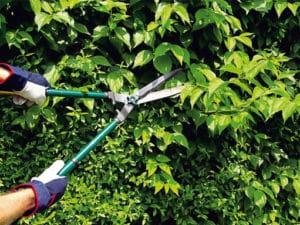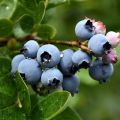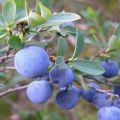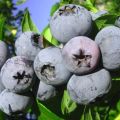Description of the Northland blueberry variety, planting and care, diseases and pests
Northland blueberry is widely known among plant growers as one of the best frost-resistant varieties, which explains its widespread cultivation, even in regions with a harsh climate. The northern country, as the name of the plant is translated from English, when creating comfortable conditions for growth, is able to delight for a long time and abundantly with its tasty and healthy fruits. To achieve high results from this amazing bush, you need to know its strengths and weaknesses, the basic rules for planting and care.
Northland blueberry breeding history
This relatively thermophilic plant is cultivated in the western hemisphere. Northland blueberries were bred in 1952, although work began in 1948. It was authored by C. Johnston and J. Moulton from the University of Michigan in the USA. The Berkeley variety, which is distinguished by its tall growth, and the 19-H hybrid obtained from the compact blueberry and the Pioner seedling, were used as a parental pair. In 1967, Northland blueberries were included in the State Reyestr of the Russian Federation.
Pros and cons of culture
When growing Northland blueberries, the following positive characteristics were observed:
- high level of frost resistance;
- early ripeness of fruits;
- compact size of the bush;
- excellent consumer and commercial qualities;
- high rates of productivity;
- not whimsical to growing conditions and care
- increased immunity to major ailments and parasitic individuals;
- high decorativeness.
But Northland blueberries also have their disadvantages, which you should know about in order to get a rich harvest:
- low level of drought resistance;
- the need for additional pollinators;
- painfully tolerates drafts and strong gusts of wind;
- grows well only on soils with high acidity;
- the breeding process is slow.
Despite some disadvantages of Northland blueberries, its benefits completely overlap them, making it one of the most popular.
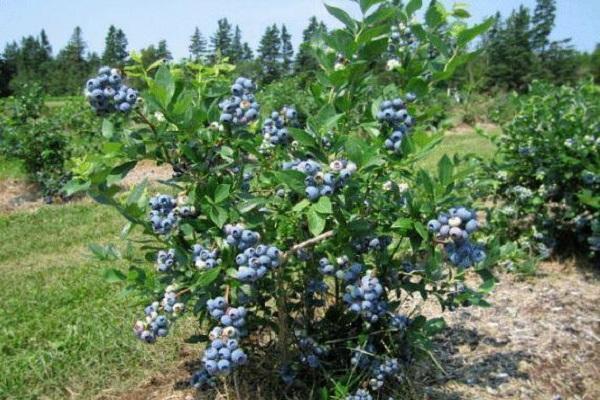
Description and characteristics of the variety
Northland blueberries belong to the category of collective plants; planting them in single copies is ineffective. Knowing all the main characteristics of a culture, it is possible to understand what conditions it needs for normal growth and development.
Bush and root system
Northland blueberry is a low-growing plant, its height is no more than 1.2 meters. The bush is distinguished by its spreading and powerful trunk, forms a dense growth. The type of root system is fibrous, located close to the soil surface. No root hairs are observed.
Shoots are erect and even, their green color remains throughout the year. Thanks to the strong branches, the bush is not afraid of the load of snow. The leaf plates of Northland blueberries have a glossy surface, the color in summer is rich green, by autumn it changes to fiery red. Their length is no more than 3 centimeters.
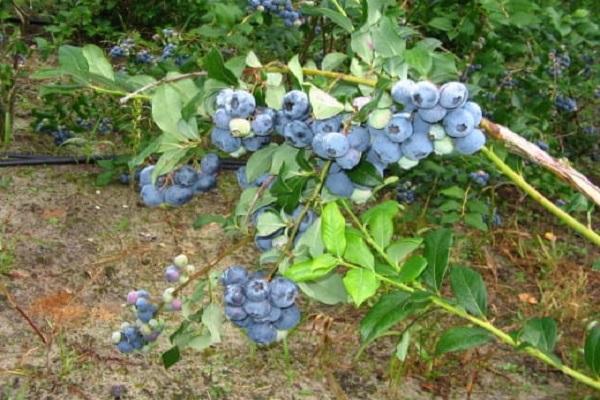
Northland blueberry inflorescences grow small in size, outwardly they resemble bells. Their color is pale pink. Round berries have a fairly dense structure, their average size is 1.6 centimeters. A light bluish bloom is visible on the light blue skin. The consumer qualities of Northland blueberries are excellent: the taste is sweet, harmonious, the aroma is pronounced.
Northland blueberry fruits have a tasting score of 4.0 points out of 5.
Flowering and yield
The flowering phase of Northland blueberries begins in late spring, and the fruiting period lasts about three weeks. Given the mid-ripening of the culture, ripening occurs in mid-July and lasts until August.
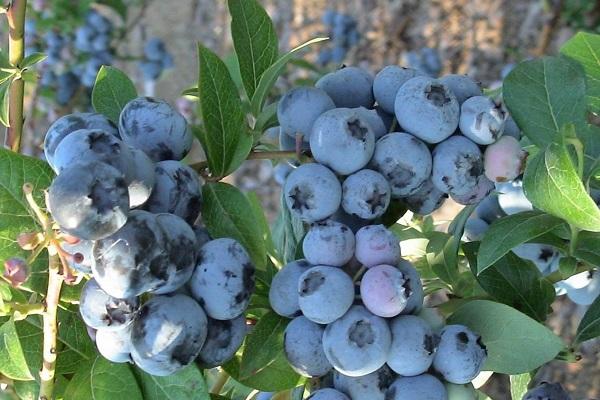
Harvesting is recommended 2-3 times a week, as Northland blueberries tend to shatter quickly.
The culture begins to bear fruit in the second year after planting in a permanent place. It gives a crop stably and abundantly, productivity indicators are 4-5 kilograms from one planting, under favorable conditions - up to 8 kilograms. The life span of the bush is up to 30 years.
Scope of berries
Northland blueberry fruits are versatile. They can also be used to prepare various desserts, compotes, and preserves. They are especially useful for the body fresh.
Disease and pest resistance
Northland blueberries have a high degree of resistance to major diseases, especially to the fruit mummification virus, and harmful insects.
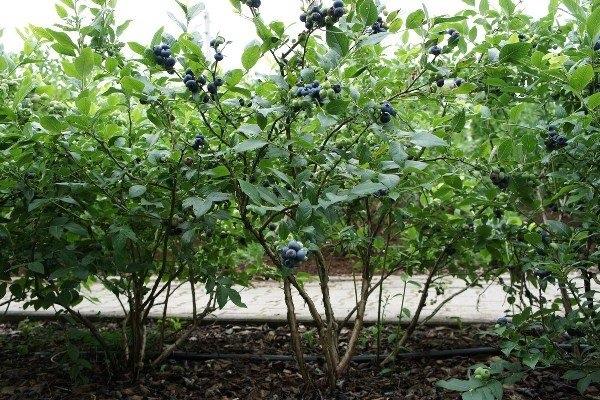
Susceptibility to diseases and parasites
In case of violations of agricultural technology and unfavorable weather conditions, the culture can overtake such diseases as gray rot, physalosporosis, stem cancer, moniliosis. If the bush has undergone a viral or fungal disease, then in most cases it should be disposed of completely.
Of the pests, Northland blueberries are often attacked by kidney mites, small aphids and flower beetles. In addition, feathered ones do not mind eating sweet and juicy berries. To protect the crop from them, it is recommended to use strips of polymer film, which are fixed on the branches of the bush.
Landing technology
It is not easy to grow Northland blueberries in regions with a changeable climate, but it is quite possible, the main thing is to create favorable conditions for its growth from the beginning.

Timing
Planting is recommended to be carried out either in early spring, when warmth is established and the threat of return frosts has passed, or in autumn. But it is preferable to plant Northland blueberry seedlings in spring, so that they have time to adapt to new conditions and prepare for wintering.
Preparation of soil and planting pit
For better growth and development, you need to choose a site for planting Northland blueberries in a clearing that is well lit and protected from cold winds. Planting in the shade does not produce the desired results. It is not advisable to place the bushes near tall garden plantings, otherwise the berries will be sour.
The soil at the planting site should not be depleted, the seedlings are in great need of nutrients. The best option is light, well-drained soil, saturated with useful components - humus. The acidity index should be in the range of 3.5-5.0.For growing crops, it is effective to use high-moor peat or a composition based on it.
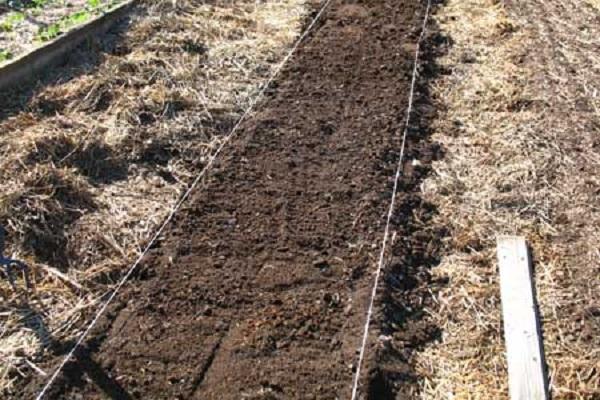
Cooking a seedling
To avoid further problems with the plant, it is recommended to purchase planting material in special nurseries or at exhibitions. Saplings should be with a closed root system, two years old and a shoot length of 35-50 centimeters. Before planting, the container with the plant should be kept in a container with water for 30 minutes.
Algorithm and scheme of disembarkation
In order for a young plant to take root and grow faster, it is necessary to adhere to the following technology:
- Dig a hole 50 centimeters deep and 50-60 centimeters wide.
- Lay a drainage cushion of expanded clay, pebbles, crushed stone on the bottom (layer thickness 7-10 centimeters).
- Fill the pit with a nutrient composition of peat, soil, coniferous litter and humus by 10-15 centimeters.
- Place the prepared seedling in the center of the hole and spread its roots.
- Sprinkle with soil mixture and carefully compact it so that there are no voids.
- Mulch with sawdust, peat or pine nut shells (layer thickness 5-10 centimeters).
- Moisten the soil with acidified water, where 40 grams of citric acid is used for 10 liters of liquid.
The optimal distance between plantings is 1.5 meters, and between rows 2-2.5 meters.

Rules of agricultural technology and care
Basically, caring for Northland blueberries comes down to performing irrigation measures, loosening the soil, and adding nutrient mixtures.
Watering and fertilizing
The blueberry bushes should be moistened regularly, once every 7 days. And in the fruiting phase - once every 4-5 days. The volume of water per adult plant is 10 liters. It is divided into 2 doses, irrigating the bushes in the morning and evening hours. It is more efficient to use a drip irrigation system for watering blueberries.
For feeding procedures, it is recommended to use preparations with a high concentration of nitrogen, as well as complex mixtures. The first time fertilizer is applied at the initial stage of sap flow, the second - in the flowering phase and the third - during the formation of ovaries.
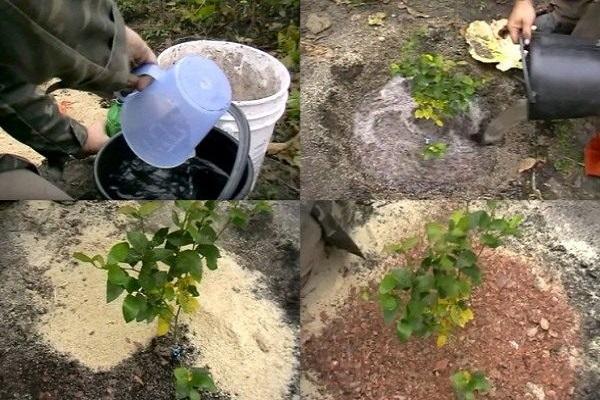
It is undesirable to add organic compounds to the soil, they have a detrimental effect on blueberry bushes.
Mulching and loosening the beds
So that cultivated plants do not experience a deficiency of nutrients and moisture, it is necessary to periodically remove weeds near them. And loosening the soil will avoid oxygen starvation of the roots, but it should be carried out carefully, to a depth of 10 centimeters.
To retain moisture in the soil, you need to use mulch, for example, peat, sawdust, crushed tree bark, grass. The layer thickness should be at least 5 centimeters.
Formative shrub pruning
Given the slow growth rate of shoots, you should not get too carried away with pruning them. To create a more compact shape, the branches of the bush should be tied up. In the spring, the plantings are inspected and rid of incapacitated branches, including those infected with pathogenic microorganisms.
Pruning helps prevent them from being damaged by the weight of the snow. To increase the productivity of Northland blueberries, shoots older than 7 years are removed, and five-year-old branches are pruned to increase the size of the berries.

Methods of control and prevention of diseases and insects
Against stem cancer and gray rot, it is recommended to avoid waterlogging of the soil and excessive amounts of nitrogen-containing fertilizers. In case of infection with these ailments, Fundazol and Topsin work effectively. Similar drugs are used for physalosporosis, and the Bordeaux mixture has proven itself well against moniliosis.
Insecticides such as Actellika, Karate, Calypso will help protect plantings from aphids. It is possible to fight the kidney mite with the help of ferrous sulfate, Nitrofen, KZM.You can defeat the flower beetle by using Fufanon, Intavir.
Preparing for winter
When growing Northland blueberries in areas with harsh winters, additional shelters should be used: spunbond, burlap. The use of polyethylene can cause the bushes to rot. In addition, top dressing with a high concentration of magnesium should be added to the soil (at the end of August).

Variety reviews
Northland blueberries have proven themselves mainly on the positive side. She is chosen for its relative unpretentiousness to the conditions of detention and high productivity.
Alexey, 56 years old, Saratov
The variety was planted quite recently, but has already managed to assess its frost resistance. Of course, I still sheltered young plants, and when they grew up, they cope with low temperatures quite normally.
Anna, 46 years old, Novgorod
I liked the Northland blueberry for its high yield and ease of care. There is no special need to carry out formative pruning, it is enough to water the plant in a timely manner and introduce nutrient compositions.

